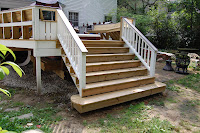
Our neighbor and good friend's chocolate lab, Keely, is having puppies. Well, I was asked to help build a Whelping Box. "I have no idea what one is, but I am in...let's do it," was my reply. Now, I guess if I bred dogs, I'd know. As I found out, the internet is filled with whelping boxes you can purchase, build, etc. Some enterprising people are even using children's swimming pools...successfully.
Well, a whelping box is simply a box large enough to accommodate the pregnant mother where she can "nest" to deliver the puppies and then ultimately nurse them for 6 to 8 weeks. The specs are based on the size of the dog, but the requirements are simple. Build a box large enough to hold momma, however many puppies she may have, and provide them all the ability to nurse, cuddle, sleep and do other adorable doggie stuff. The box walls need to be high enough so the puppies can't get out (especially once they become curious at a few weeks old) and low enough for momma to come and go as she pleases.
This was a simple 2 hour, less than $100 project.
- 2 sheets 3/4" 4x8 plywood
- 2 10' 2x4s
- 8 door hinges (ones with removable pins)
- 2 latches
- a few drywall screws
- plastic
Since we're building for a lab, we decided the to make the box 4' x 5' with 20" high sides. We will hinge one side in the middle to allow for easier momma access, especially when the pups are small. We can then raise this side for max height once they begin to grow. Now you may ask, why all the hinges. We decided to make the box quick and simple to break down. So instead just screwing the sides together, we used door hinges on each corner. Pop all the pins and we have 5 flat sheets of plywood to store.
Here's what we did. Cut the 4 sides. Two at 20" x 4' and two at 20" x 5. We then took one of the 4' sides and ripped it down into two equal 10" x 4' pieces. We hinged this piece in the middle. We then used hinges on each corner create a rectangular box. We used 2 hinges on the fixed corners and one hinge on the bottom of the hinged-side corners. The latches were used to hold the top of those two corners together. Once the rectangle was built, we cut the a 46" x 5' piece to fit in the bottom. We covered this in plastic to resist being too saturated in urine. We laid the 2x4's cut to 5' lengths in the bottom of the box to act as floor joists and raise the bottom off the ground a bit.
Simple, cheap, easy. Now all we need to do is fill it with blankets and let nature take its course. I definitely don't want to be around for that.









